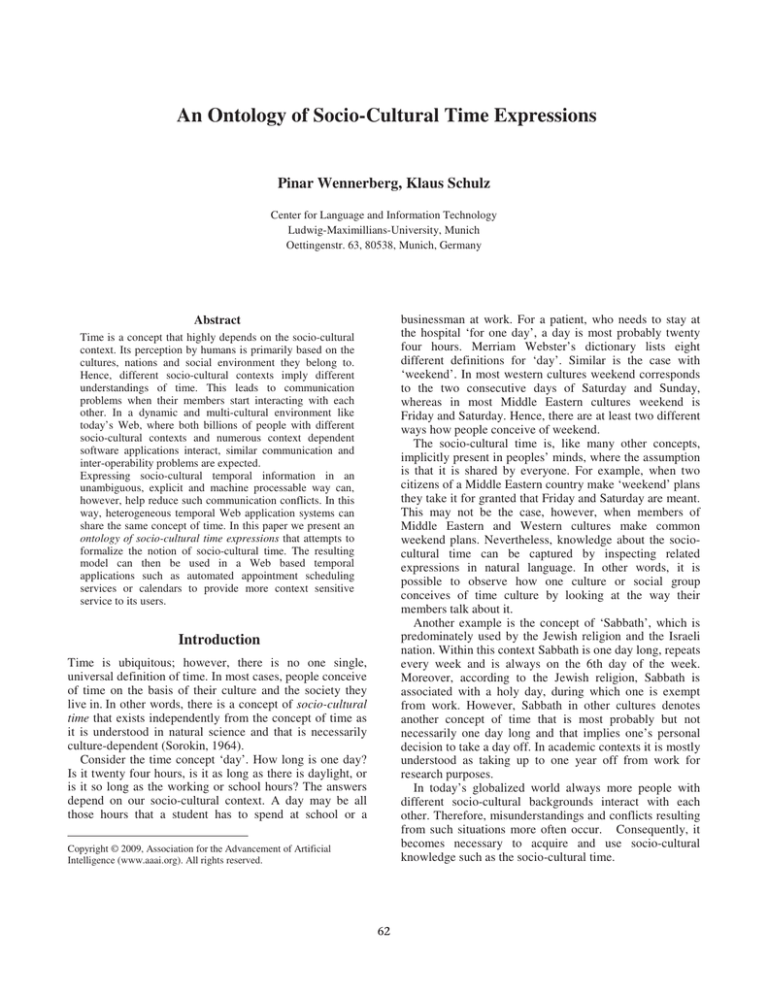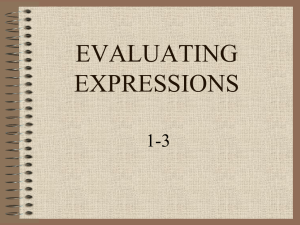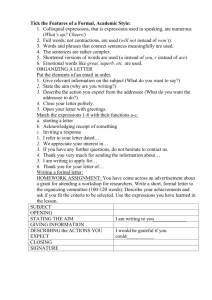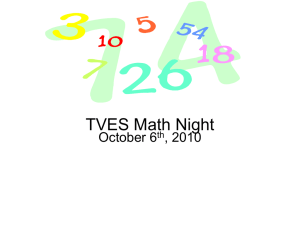
An Ontology of Socio-Cultural Time Expressions
Pinar Wennerberg, Klaus Schulz
Center for Language and Information Technology
Ludwig-Maximillians-University, Munich
Oettingenstr. 63, 80538, Munich, Germany
businessman at work. For a patient, who needs to stay at
the hospital ‘for one day’, a day is most probably twenty
four hours. Merriam Webster’s dictionary lists eight
different definitions for ‘day’. Similar is the case with
‘weekend’. In most western cultures weekend corresponds
to the two consecutive days of Saturday and Sunday,
whereas in most Middle Eastern cultures weekend is
Friday and Saturday. Hence, there are at least two different
ways how people conceive of weekend.
The socio-cultural time is, like many other concepts,
implicitly present in peoples’ minds, where the assumption
is that it is shared by everyone. For example, when two
citizens of a Middle Eastern country make ‘weekend’ plans
they take it for granted that Friday and Saturday are meant.
This may not be the case, however, when members of
Middle Eastern and Western cultures make common
weekend plans. Nevertheless, knowledge about the sociocultural time can be captured by inspecting related
expressions in natural language. In other words, it is
possible to observe how one culture or social group
conceives of time culture by looking at the way their
members talk about it.
Another example is the concept of ‘Sabbath’, which is
predominately used by the Jewish religion and the Israeli
nation. Within this context Sabbath is one day long, repeats
every week and is always on the 6th day of the week.
Moreover, according to the Jewish religion, Sabbath is
associated with a holy day, during which one is exempt
from work. However, Sabbath in other cultures denotes
another concept of time that is most probably but not
necessarily one day long and that implies one’s personal
decision to take a day off. In academic contexts it is mostly
understood as taking up to one year off from work for
research purposes.
In today’s globalized world always more people with
different socio-cultural backgrounds interact with each
other. Therefore, misunderstandings and conflicts resulting
from such situations more often occur. Consequently, it
becomes necessary to acquire and use socio-cultural
knowledge such as the socio-cultural time.
Abstract
Time is a concept that highly depends on the socio-cultural
context. Its perception by humans is primarily based on the
cultures, nations and social environment they belong to.
Hence, different socio-cultural contexts imply different
understandings of time. This leads to communication
problems when their members start interacting with each
other. In a dynamic and multi-cultural environment like
today’s Web, where both billions of people with different
socio-cultural contexts and numerous context dependent
software applications interact, similar communication and
inter-operability problems are expected.
Expressing socio-cultural temporal information in an
unambiguous, explicit and machine processable way can,
however, help reduce such communication conflicts. In this
way, heterogeneous temporal Web application systems can
share the same concept of time. In this paper we present an
ontology of socio-cultural time expressions that attempts to
formalize the notion of socio-cultural time. The resulting
model can then be used in a Web based temporal
applications such as automated appointment scheduling
services or calendars to provide more context sensitive
service to its users.
Introduction
Time is ubiquitous; however, there is no one single,
universal definition of time. In most cases, people conceive
of time on the basis of their culture and the society they
live in. In other words, there is a concept of socio-cultural
time that exists independently from the concept of time as
it is understood in natural science and that is necessarily
culture-dependent (Sorokin, 1964).
Consider the time concept ‘day’. How long is one day?
Is it twenty four hours, is it as long as there is daylight, or
is it so long as the working or school hours? The answers
depend on our socio-cultural context. A day may be all
those hours that a student has to spend at school or a
Copyright © 2009, Association for the Advancement of Artificial
Intelligence (www.aaai.org). All rights reserved.
62
One of the most well-known ontologies about time is the
Time-DAML2 ontology, which is an outcome of the
collaborative efforts of a number of researchers, whose
motivation has been to develop single representation of
temporal knowledge. Its purpose is to provide annotations
for the contents of Web resources. As an example TimeDAML defines ‘weekday’ as an enumeration of Monday,
Tuesday, Wednesday, Thursday or Friday. Similarly,
‘weekend’ is defined in terms of Saturday and Sunday.
Although this definition holds for many cultures, it does
not for many others (e.g. those that do not use the
Gregorian calendar).
Abou-Zaeid (2003), on the other hand, does address the
intercultural differences with an ontology that describes
different cultural values within the international business
enterprises. However, he does not discuss the role of time.
Finally, there is much discussion about how natural
language expressions shall be modeled in ontologies. Sowa
(1998) argues that languages, be it natural or artificial, are
made up of symbols organized in well defined syntactic
structures but the real world is made up of an endless
variety of things. Therefore, it is not possible to capture the
full richness of the world by means of languages. So,
linguistic knowledge is subordinated to real world
knowledge.
Bateman on the other hand distinguishes between three
types of relationships between the natural language
expressions and the concepts they denote. Accordingly,
first relationship is subordinance, i.e. there is no theoretical
difference between the lexical information and the nonlexical. Thus both expressions of natural language the
denoted concepts are treated the same way, where lexical
information is simply subordinated to the non-lexical
information. The second kind of relationship is conceptual
if the information is non-lexical and is related to and the
psychology and it thirdly it is contextual if it is related to
sociology (Bateman, 1992).
In this paper argue that natural language is inherently
ambiguous meaning that one socio-temporal concept may
have many lexicalizations. Given this, a corresponding
socio-cultural temporal ontology, is in our view, an
agreement proposal to decide for some specific subset of
these lexicalizations so that different software applications
can share the same interpretation. The socio-cultural
temporal time expressions ontology described in the next
section is based on this view.
The situation is similar within the dynamic context of
the World Wide Web, where not only people but also
software applications coming from heterogeneous contexts
interact. These applications are developed on the basis of
the context-specific needs and preferences of their
developers and their intended users, therefore they
necessarily carry the distinct characteristics of their sociocultural contexts. This leads to interoperability problems
among the different applications, for example when
processing temporal information.
In this paper we argue that socio-cultural temporal
information needs to be described formally and explicitly
so that it can be processed by dependent software
applications. This can help avoid potential conflicts
between temporal software applications, e.g. Web
calendars that were designed to meet different cultural
needs and expectations. To achieve this goal, we propose
an ontology based model to formally, explicitly and
unambiguously describe socio-cultural temporal time
expressions. We believe that the ontology based model is
appropriate not only because its level of formality (hence
machine-processibility) but also it gives Web access to the
knowledge contained in it. To enable Web access, the
ontology of socio-cultural time expressions is implemented
as an OWL1 model. Such a model can support temporal
Web application systems such as an automated
appointment scheduling service (Spranger, 2002). The
author also discusses that current Web based appointment
scheduling services fall short in considering the notion of
socio-cultural time. On the other hand such services can
react in a more sensitive way to their users’ socio–cultural
context if they were provided with knowledge about their
temporal needs and preferences.
The rest of this paper is structured as follows. Next
section gives an overview of related work that is followed
by the section that describes the ontology in detail. Here
we discuss the contents of the ontology as well the
methods we used during its engineering process. Final
section concludes the paper with possible applications of
the ontology and future work.
Related Work
Numerous independent time ontologies for the Web exist
(Allen et. al, 2002), (Beule, 2003). There are also various
culture ontologies, which nevertheless cover the domain in
its broadest sense. Most of them provide models for
cultural heritage systems (Doerr et al., 1999), (Doerr,
2000), (Constantopoulos, 1994), (Alani, 2001), for cultures
in different enterprises and organisations (Abou-Zeid,
2003), or for culture specific language terms (Agnesund,
1997). In doing so, these ontologies consider time and
culture as concepts that are independent of each other. We
have not come across to interdisciplinary ontologies i.e.
socio-cultural temporal ontologies that address the se
concepts together.
1
Ontology of Socio-cultural Time Expressions
Socio-cultural time expressions are a subset of natural
language expressions that are related to nations, religions,
business life & education3. For example, ‘Halloween’ is an
expression that is specific for the US American nation,
2
http://www.cs.rochester.edu/~ferguson/daml/
Following Allen’s temporal classification, in our work we only consider
temporal intervals, (i.e. time units with certain duration) but not time
instants.
3
http://www.w3.org/2004/OWL/
63
‘Christmas’ is an expression related to the Christian
religion, ‘Meeting’ is an expression very often used among
business people, and ‘Academic Semester’ is an expression
used by academia.
Hence purpose of the ontology is to explicitly and
formally describe these context dependent temporal
expressions. This is done by defining appropriate
hierarchical categories to which the expressions will be
assigned. The ultimate goal is to be able to develop context
aware temporal applications for the Web such as calendars
or appointment schedulers.
The scope of the ontology is restricted to a subset of
socio-cultural time that is related to nations, religions and
business life & education. We believe that in real life
knowledge about socio-cultural time is more often
embedded in these particular socio-cultural groups. More
specifically, we focus on the Turkish, US American and
Israeli nations, the Islamic, Christian and Jewish religions,
members of secondary and higher education as well as the
group of business people. Following requirements are
defined for the design of the ontology:
1. Typing: Entries in the ontology need to be typed to
reflect the differences between the main categories. For
example, category Socio-Cultural Time Expressions and
category Calendar Date Expressions are two distinct
types. Consequently, one instance cannot be an instance
of both categories.
2. Category Combination: Combining existing categories
can yield new categories. For example, category SocioCultural Time Expressions Related to Nations can be
combined with the category Socio-Cultural Time
Expressions Denoting a Time Period of One Day to
obtain the category Socio-Cultural Time Expressions
Related to Nations Denoting a Time Period of One Day.
3. Stability: Local changes cannot affect the other parts of
the ontology, i.e. additions and deletions in one category
will not lead to changes in other categories.
4. Extensibility: It should be possible to extend the
ontology at arbitrary depth and branching level.
5. Graph Structure: One category can be found starting
out from different categories. Therefore, multiple
parents are allowed.
Furthermore, there are some naming conventions. As a
rule, names of the categories start with a capital latter as in
Socio-Cultural Time Expressions Denoting Time Periods.
Names of instances also start with capital letters, however,
they are single quoted, as in ‘Holiday’. Property (attribute)
and relations’ names begin with lowercase as in
has_Duration or in subclassOf.
Methodology. We applied a specific methodology, the
METHONTOLOGY (Sierra, et.al., 1999) as it gives
precise guidelines for the engineering process.
Accordingly, each step in the engineering process needs to
be documented in detail before starting with the
implementation. One of these documents is the concept
dictionary that lists all the concepts, properties and
relations that are to be included. Figure 1 shows a subset.
Figure 1: Concept dictionary according to METHONTOLOGY
listing all entries in the ontology.
Category hierarchy. The hierarchical structure of the
Ontology of Socio-Cultural Time Expressions has the form
of a directed acyclic graph (DAG). The top level category
is ( ) and all other categories are its subcategories. The top
category has one subcategory Time Expressions Denoting
Time Periods. This category includes all possible
expressions about time, which denote concepts that can be
explicitly anchored on the timeline. Examples are
expressions about, calendar dates, days of weeks, months,
hours of days, years, weekends, summers, winters etc.
Temporal expressions denoting concepts that cannot be
explicitly anchored on the timeline, are not within the
scope of the ontology. Examples of such expressions are
“sometime in future”, “a while ago”, “whenever possible”,
“way before”, etc.
Subcategories of a category have the same criterion of
subdivision. Thus, the top category is subdivided along the
question “Does the time expression denote merely a
calendar date time period, or does it denote a time period
that is related to one of the socio-cultural groups specified
within the scope of the ontology?” Consequently, all time
expressions that denote merely calendar date time periods
are classified under the Calendar Date Expressions
Denoting Time Periods category. Expressions that belong
to this category are those time expressions that explicitly
denote a time interval in a given calendar such as calendar
days, calendar weeks, months, hours, e.g. “12.6.2004”,
“January”, “12.00 p.m.”, “8.00a.m.”, etc.
Remaining time expressions bear socio-cultural
characteristics, therefore they qualify as expressions
denoting socio-cultural time periods. They are classified
under the second category Socio-Cultural Time
Expressions Denoting Time Periods. Thus, Calendar Date
Expressions Denoting Time Periods and Socio-Cultural
Time Expressions Denoting Time Periods are third level
co-ordinate categories (i.e. both at the same level).
Categories can be sub-, super-, or co-ordinate categories of
each other w.r.t. their hierarchical relations. A category has
all the characteristics of its super-category and at least one
other characteristic, which distinguishes it from its super-,
and co-ordinate categories. Thus, both categories Calendar
Date Expressions Denoting Time Periods and SocioCultural Time Expressions Denoting Time Periods extend
64
Fixed Date property marked as true (and has has Variable
Date marked as false for that matter). Figure 4 shows
example properties.
the category of Time Expressions Denoting Time Periods
with further characteristics and they are distinct.
Time expressions that belong to Calendar Date
Expressions Denoting Time Periods additionally denote
explicit time periods. As counter examples, ‘Bed Time’,
‘Tomorrow’, ‘Last Month’ cannot be instances of the
category Calendar Date Expressions Denoting Time
Periods because they are not explicit i.e. they are fuzzy.
Time expressions that belong to the category of SocioCultural Time Expressions Denoting Time Periods are
those bearing socio-cultural characteristics. For example,
‘Columbus Day’ denotes a time period of one day and it is
an expression used in the USA. Likewise, ‘Yom Kippur’ is
also a concept denoting one day and it is used in the Jewish
religion and the Israeli nation. Socio-Cultural Time
Expressions Denoting Time Periods is further divided into
two categories along two criteria; the duration of the time
period (temporal dimension) they denote and the origin of
the expression (socio-cultural dimension). Consequently,
following subcategories emerge; Socio-Cultural Time
Expressions Denoting Time Periods Related to Nations,
…Related to Religions, … Related to Business Life &
Education, Socio-Cultural Time Expressions Denoting
Time Periods with Duration of One Day, …with Duration
of Longer than One Day and finally …with Duration of
Shorter than One Day, which are each other’s co-ordinate
categories. Figures below show the high level and the
combination categories respectively.
Figure 4: A selection of properties and instances of the ontology.
Instances. Instances of the ontology are natural language
expressions of socio-cultural time denoting time periods,
e.g. ‘Octoberfest’, ‘Academic Trimester’ or ‘Day of
Repentance and Prayer’. Every instance is assigned to an
appropriate category. For example, ‘St. Patrick’s Day# is
an instance of the category Christian Time Expressions
Denoting Time Periods of One Day and ‘Academic
Trimester’ is an instance of Socio-Cultural Time
Expressions Related to Higher Education Denoting Time
Periods with Duration of Longer than One Day. Some
categories do not have direct instances but only in terms of
their subcategories. For example, ‘St. Patrick’s Day' is an
instance of Socio-Cultural Time Expressions Denoting
Time Periods the category Christian Time Expressions
Denoting Time Periods with Duration of One Day as the
latter is the subcategory of the former. Figure 5 shows a
selection of instances of the ontology.
FIGURE COMBINATION
Figure 2: Top and high level categories of the ontology along the
classification criteria.
Figure 5: Examples of instances with their respective categories.
Figure 3: Mid-level combination categories.
Conclusions and Future Work
Relations and Properties. Some properties defined are
has Fixed Date, has Variable Date, implies General
Suspension of Classes, and finally implies General
Suspension of Work. Each has Boolean values that can be
true or false. In this case ‘St. Valentine’s Day’, which
repeats every year on the 14th of February, will have its has
This paper discussed the need for an ontology about sociocultural time for the Web that formally describes how time
is perceived in different social and cultural groups.
Subsequently, we described the ontology of socio-cultural
time expressions that is designed to address this need.
65
Reference Model. Tech.
Documentation Standards.
There can be various possible use cases based on the
ontology, for example providing temporal semantic
annotation for the Web to support Web calendars, Webbased appointment scheduling systems or a temporal type
system that uses it to enable calendrical calculations.
Currently, the ontology models the temporal domain
only on the basis of the Gregorian calendar. To refer to
broader socio-cultural groups it can be extended to include
other calendar types such as Islamic, Hebrew etc.
Furthermore, to conduct calendrical calculations, the
ontology essentially needs to be connected to a temporal
type system, as discussed in Bry and Spranger (2004).
Finally, manual acquisition of socio-cultural temporal
expressions is a laborious task that needs support. Such
expressions can be extracted from text (or Web) semiautomatically using information extraction approaches to
populate the ontology.
Report,
ICOM/CIDOC
Doerr M. 2000. Mapping of the Dublin Core Metadata
Element Set to the CIDOC CRM. Tech. Report.
Constantopoulos, P.1994. Cultural Documentation in the
CLIO System. Tech. report TR94-0115, tech. report 115,
ICS-FORTH, Heraklion Crete, Greece, January 1994.
http://citeseer.ist.psu.edu/constantopoulos94cultural.htm
Sorokin, P. 1964. Socio-Cultural Causality, Space, Time,
New York: Russell & Russell.
Spranger, S. 2002. Representation of Temporal Knowledge
for Web-based Applications. Master’s Thesis. LMU Institut
für Informatik Lehr- Und Forschungseinheit für
Programmier- Und Modellierungssprachen, 2002, May,
Pp. 54--70.
References
Sowa, J.F. 1998. Knowledge Representation: Logical,
Philosophical, and Computational Foundations. PWS
Publishing Co.
Abou-Zeid, E. 2003. Towards a Cultural Ontology for
Interorganizational Knowledge Processes. In Proc. of 36th
Hawaii International Conference on System Sciences
HICSS-36, pp. 4--9.
Sierra, J.P., Sierra, A.P., Goméz Peréz, A., Fernández
López, M.1999. Building a ChemicalOntology Using
METHONTOLOGY
and
the
Ontology
Design
Environment. IEEE Intelligent Systems, 1999.
Agnesund, M. 1997. Representing Culture-Specific
Knowledge in a Multilingual Ontology. In Proc. of the
IJCAI-97 Workshop on Ontologies and Multilingual NLP.
Allen, J. 1983. Maintaining Knowledge about Temporal
Intervals. Communications of the ACM.
Alani, H. Spatial and Thematic Ontology in Cultural
Heritage Information Systems. 2001. PhD. Thesis.
University of Glamorgan/Prifysgol Morgannwg UK.
Allen, J., Fikes, R., Hayes, P., McDermott, D., Niles, I.,
Pease, A., Tyson, M., Waldinger, A., Hobbs, J.R.,
Ferguson, G. 2002. A Daml Ontology of Time. Tech.
Report, DAML.org.
Bateman, J.A. 1992. The Theoretical Status of Ontologies
in Natural Language Processing. In Susanne Preuss and
Birte Scmitz (eds.) Text Representation and Domain Modelling Ideas from Linguistics and AI. KIT Report-97.
pp. 50-99
Beule, J. De. 2003. Creating Temporal Categories for an
Ontology of Time. In Proc. of CLIN 2003, 14th Meeting of
Computational Linguistics in the Netherlands, 19
December Antwerpen, Belgium.
Bry, F., Spranger, S. 2004. Towards a Multi-calendar
Temporal Type System for (Semantic) Web Query
Languages. Proc. of Workshop on Principles and Practice
of Semantic Web Reasoning, Springer.
Doerr, M., Stif, M., Crofts, N., Dionissiadou, I. 1999.
Definition of the CIDOC Object-Oriented Conceptual
66







